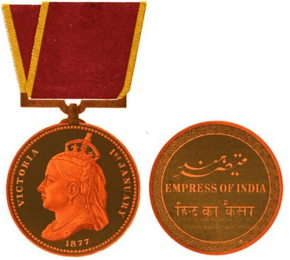Empress of India Medal facts for kids
The Empress of India Medal was a special medal given out in 1877. It celebrated a very important event: when Queen Victoria was officially declared the Empress of India. This medal was the first of its kind. It was the first medal people could actually wear that celebrated a special event in the British Empire.
Some medals were made of gold and given to important Indian princes and high-ranking officials. Others were made of silver. These went to certain British and Indian military officers and civilians. One soldier from every British and Indian army group in India also received a silver medal. This happened during the big celebration in Delhi in 1877, called the Delhi Durbar.
Contents
A Look Back: The Medal's History
The idea of giving out medals for royal events started a long time ago. In 1547, medals were made to celebrate King Edward VI becoming king. But these were more like special coins or medallions. They were not meant to be worn.
The Empress of India Medal was different. It was the first official medal that people could wear to remember a royal event. It marked the moment Queen Victoria was announced as Empress of India. This big announcement happened at the Delhi Durbar on January 1, 1877.
What the Medal Looked Like
The Empress of India Medal was made in two types: one from gold and one from silver. It was quite large, about 58 millimeters (or 2.3 inches) across. This was almost 20 millimeters bigger than most military medals.
On the front of the medal, you could see a picture of Queen Victoria. She was wearing a special crown and a veil. Around the edge, it said Victoria 1st January 1877.
The back of the medal had the words Empress of India written in three languages. It was in English, Hindustani (Hind-ka-Kesar), and Persian (Qaisar-e-Hind). There was also a pretty pattern around the edge.
The medals usually did not have names on them when they were given out. However, some people later had their names carved onto their medals privately.
The medal was worn around the neck on a special ribbon. The ribbon was crimson (a deep red color) with thin yellow stripes along its edges. It was about 42 millimeters (1.65 inches) wide.
Who Received the Medal
The gold medals were given to Indian princes and important government officials. The silver medals went to chosen British and Indian military officers and civilians. Also, one soldier from each British and Indian army group serving in India at that time received a silver medal.
Interestingly, British and Indian army officers and soldiers were not allowed to wear this medal with their uniforms. However, Indian princes and civilians often wore theirs proudly.
The Special Award Ceremony
During the big Delhi Durbar celebration, the Viceroy of India played a key role. The Viceroy was like the Queen's main representative in India. He wore special robes as the Grand Master of the Order of the Star of India.
He met each of the 63 ruling princes of India one by one. As each prince came forward, the Viceroy did something special. He placed a crimson ribbon around the prince's neck. Attached to this ribbon was a beautiful gold medal with Queen Victoria's head on it.
The Viceroy would then say, "I decorate you, by command of Her Majesty. May this medal be long worn by yourself, and long kept as an heirloom in your family in remembrance of the auspicious date it bears." This meant the medal was a gift from the Queen. It was meant to be worn for a long time and passed down in the family. It would help them remember that important day.
Notable Recipients
- Jung Bahadur Rana
- Vijaya Mohana Muktamba Bai
- Sultan Jahan, Begum of Bhopal
- Seth Baldeo Dass Sarda of Punjab
- Bhagvatsinhji
- Sayajirao Gaekwad III
- Raghubir Singh Jind
- Kasturchand Daga
- Kalb Ali Khan
- Mahboob Ali Khan
- Muhammad Mushtaq Ali Khan
- Khengarji III
- Ranodip Singh Kunwar
- Hira Singh Nabha
- Nripendra Narayan
- Ramachandra Tondaiman
- Chandra Shumsher Jang Bahadur Rana
- Jayajirao Scindia
- Shivaji VI
- Pratap Singh of Jammu and Kashmir
- Jaswant Singh of Bharatpur
- Lakshmeshwar Singh
- Rameshwar Singh
- Ranbir Singh of Jammu and Kashmir
- Shah Jahan Begum
- Visakham Thirunal
- Ayilyam Thirunal


